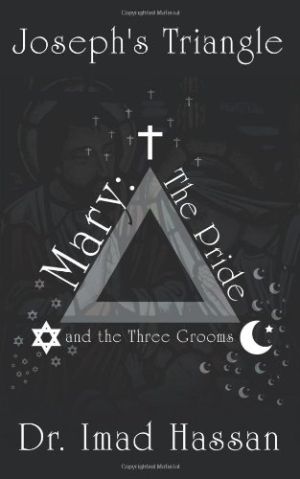Joseph's Triangle
Mary: the Pride and the Three Grooms
In the first part of the Joseph’s Triangle, Imad Hassan investigates a topic not often analyzed in scriptural studies. His hypothesis is that a marriage between Mary, the mother of Jesus, and Joseph never occurred. Although no gospel of the Bible makes any specific mention of a marriage ceremony, you can find several passages in which a marriage and a family are inferred. Nonetheless, Hassan states his doubts and bases his theory on two unusual avenues of thought.
One of Hassan’s arguments is based on an investigation of the rendering in English of the word virgin. Hassan claims that “the word translated as ‘virgin’ is believed to be ‘Betul’ or ‘Batul’ in the original language.” Most scholars, however, agree that the author of the book of Isaiah used the Hebrew word almah. Batul is an Arabic word that, rather than meaning one who has never had a sexual relationship, refers to a lifestyle of absolute abstinence—whether for spiritual or cultural reasons—and therefore, according to the author, “cannot be a mother.” Hassan’s interpretation that “the Messiah was expected to be conceived miraculously by a highly spiritual woman…devoted to the service of God” would be incongruous with the fact that Mary had married and had other children.
It appears unorthodox and unconvincing to assert that the marriage of Mary and Joseph never occurred based on the etymology of the Arabic word batul rather than the word almah in the original Hebrew.
Hassan’s second major argument focuses on the differing genealogies of Jesus in the gospels of Matthew and Luke. Since the genealogies differ in length, direction, and names, Hassan raises the question of their reliability. Furthermore, these genealogies name several unsavory persons, most notably David, who is guilty of adultery and murder, and Hassan asserts that this lineage maligns the future generations, including Jesus. Hassan concludes that the dilemma inherent in the genealogies “not only shakes the credibility of the claimed Marriage of Mary, but also the authenticity of the whole of the gospels.”
By itself, this is quite a strong assertion. Interestingly, Hassan continues by assigning an even more sinister motivation to the genealogies. He writes that “by studying the details of the genealogies from the Jewish and scriptural points of view, it will be clear to spot who fabricated the whole story and why!” Unfortunately, this intriguing but unusual hypothesis devolves into a discourse not about scriptural fact but conspiracy theory.
In the later chapters of the book, Hassan relies on the Qu’ran to resolve the issue quite neatly. Since the Jews rejected Jesus as the Messiah and since the gospels emanate from a Jewish culture, Hassan argues that “there is little doubt that those who rejected Jesus as the Messiah were unlikely to pass an accurate record about him to the gentiles.” Conveniently, Joseph, the husband of Mary, is never mentioned in the Qur’an, and so Mary’s marriage to him is impossible.
Christian readers may at first be enticed and intrigued by the subject matter, and Christian scriptural scholars will be anxious to understand the merits of the hypothesis. Quite quickly, though, these readers will realize that the book is more personal opinion than scriptural scholarship. Hassan offers no footnotes or bibliography to bolster his claims or to mitigate opposing views.
As Albert Schweitzer notes in his seminal study The Quest of the Historical Jesus, “if a difficulty arises in regard to the Holy Scripture and we cannot solve it we must just let it alone.” Schweitzer’s advice in this regard seems quite reasonable.
Reviewed by
Thomas H. Brennan
Disclosure: This article is not an endorsement, but a review. The publisher of this book provided free copies of the book and paid a small fee to have their book reviewed by a professional reviewer. Foreword Reviews and Clarion Reviews make no guarantee that the publisher will receive a positive review. Foreword Magazine, Inc. is disclosing this in accordance with the Federal Trade Commission’s 16 CFR, Part 255.

